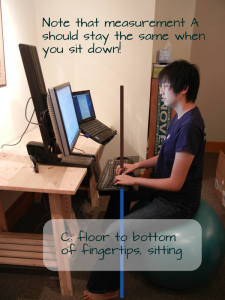Fitting yourself a sit-to-stand desk
It's been a while since I wrote about geeky things, and a few hours of setup and calibration... and it makes me smile every time I use it.
Design criteria:
- A sit-stand workstation that makes use of my existing laptop, monitor, and keyboard/mouse.
- Assisted lifting that does not require power - which means hydraulics or springs or levers or something of the sort. Sorry, geekdesk.
- Affordable on a grad student's budget. (This desk is the most expensive piece of furniture in my apartment, but it's also the one I'll spend the most time at. The bed is the second most expensive, and it's probably the one I'll spend the second most time using, so this seemed fair.)
- Sturdy -- which, for something this specialized and load-bearing, means getting quality components meant for the use, rather than cobbling together stacks of boxes and books and clamps myself.
- Portable, such that I can disassemble the components and haul them to the next place in a minivan (better yet: car).
I wanted a sit-stand workstation because I spend ridiculous amounts of time on my computer and am the restless sort, so being able to change positions and maintain proper alignment while I fidget around is a real boon to ergonomics. I've made makeshift sitting and standing desks for years, from kitchen counters to book piles to a strategically placed empty dresser, but no matter how well I set them up, a static desk just didn't seem right.
The past few years of experimentation did teach me about how one should be aligned in both sitting and standing positions, though.
Once you know the proper alignment, all you have to do is measure three dimensions, then figure out how to buy or craft the components so the desk will fit you. Here's what to measure on yourself:
Based on that, you need equipment with the following specs:
- A = vertical distance between monitor top and keyboard bottom
- B-C = vertical distance the sit-stand mechanism needs to adjust
- Don't forget to get the weight of your monitor, keyboard, and laptop, or whatever you're thinking about putting on your sit-stand mechanism, and making sure it can support and lift that!
For all of these, it's a good idea to get things that adjust beyond the minimums you need - for instance, if my next laptop is bigger and heavier, the stand should still support it. One thing I appreciate about my chosen stand is that the monitor can adjust both together with and independently of the keyboard - that way I can move the whole setup up and down in one go (since dimension A does not change between sitting and standing), and also change the keyboard-monitor height difference (for instance, if a taller friend wants to use my computer for a bit).
Here are the relevant specs on the sit-stand workstation I chose. They didn't specify dimension A precisely, but the pictures and the 5" of dimension-A-adjustment specification convinced me that I could get it to fit within my range.
- Weight Capacity: Maximum load on height-adjustment assembly = 31 lbs (14 kg). LCD weight = 6–16 lbs (2.7–7.2 kg), laptop = 6–10 lbs (2.7–4.5 kg), combined weight of LCD/laptop = 12–26 lbs (5.5–11.8 kg)
- † Lift Range: LCD and keyboard adjust 18" (46 cm) in tandem; LCD and laptop adjust 5" (13 cm) independently; maximum LCD/laptop height adjustment = 23" (58 cm)
My final bill of materials:
- 2 IKEA Vika Artur trestles, $30 each
- 1 IKEA Vika Furuskog tabletop, 30"x60", $60
- 1 Gaiam balance ball, medium/65cm, $25
- 1 Ergotron Work-Fit S, Laptop & LCD Sit-Stand Workstation, $390 plus $45 ground shipping
Total: $580 USD
You'll notice I chose to put the monitor stand on a giant desk, and use the same surface for digital and paper work. I could also put it on a small table and use that as solely a computer workstation, then have a big desk separate from that just for papers and workshop-type adventures -- and I may, depending on the nature of my lab classes in the fall semester (if I have any) or whether I start doing hobby electronics or something of the sort. If you go this route, you can do the whole thing for under $500; just get the ergotron and a cheap but sturdy folding card table, or a small computer desk at Goodwill, and you'll be all set with a more compact computer desk than mine.
It's not perfect; I've yet to figure out cord management, and adjusting the tension on the spring so it counterbalanced my computer equipment precisely took a bit of awkward fiddling 'till I got it right, but I'm a huge fan. Over the next few months, we'll see how my back and productivity feel, but as of day 3, I like it very much, and find myself moving it up and down frequently enough (multiple times an hour -- told you I was restless) to think I've made a rather good investment in this setup.
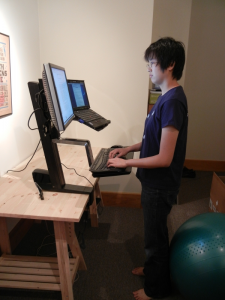
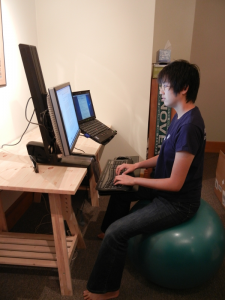
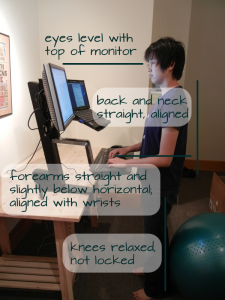
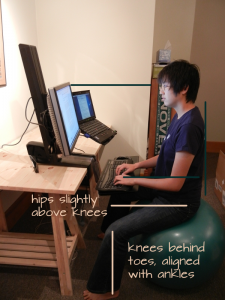
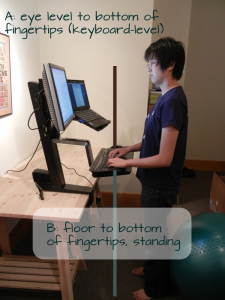 '
'